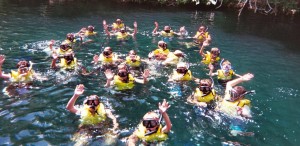“Barrier analysis” is a concept which originated decades ago with government and industrial accident investigations and accident prevention efforts. While the barrier analysis concept has not routinely been associated with risk management in the outdoor recreation field, extensive discussion of same is made in Kauffman, Integrated Risk Management for Leisure Services, 2013.
 Barrier analysis involves the relationship between a hazard and the activity participants such as Scouts, and the use of one or more “barriers” to protect the participant from the hazard. Barriers may be equipment-based (such as PFDs), physical barriers (fences), warning devices (caution tape, warning signs, swim area ropes), procedures and protocols (such as provided by the Guide to Safe Scouting, Safe Swim Defense, Safety Afloat, etc.), organizational culture and attitude (unit risk management culture), and qualified supervision (adult leaders).
Barrier analysis involves the relationship between a hazard and the activity participants such as Scouts, and the use of one or more “barriers” to protect the participant from the hazard. Barriers may be equipment-based (such as PFDs), physical barriers (fences), warning devices (caution tape, warning signs, swim area ropes), procedures and protocols (such as provided by the Guide to Safe Scouting, Safe Swim Defense, Safety Afloat, etc.), organizational culture and attitude (unit risk management culture), and qualified supervision (adult leaders).
The “barrier” functions to insulate or shield Scouts and leaders from the potential effect of the hazards, the responsibility for implementation of which falls on the shoulders of the adult leader as part of the standard of care.
Unfortunately, few barriers can operate with guaranteed success to prevent an incident from occurring. And, there are limitations to the effectiveness of barriers – the placement of a barrier may not be practical, the barrier may fail, the barrier may not be effective under all conditions, the participant may refuse or not use a barrier, or the leader fails to institute use of a barrier. For instance, there are reports on the web of Scouts drowning due to a PFD coming off while rafting, or swimming without a PFD in a river. Under those circumstances, the PFD became an ineffective barrier!

The proper planning for an activity thus not only involves a determination of what risks and hazards are reasonably foreeseeable, but what “barriers” can be put in place in an attempt to negate the effect of such risks and hazards, and then ensuring that the barriers are adequately employed. It is all part of exercising the requisite standard of care . . .
P.S. BSA employs “barrier analysis” in its 2015 “Barriers to Abuse” initiative.
